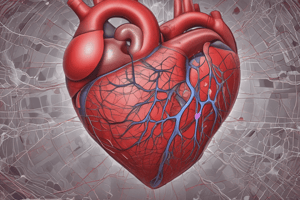Podcast
Questions and Answers
Which medication is commonly used for the treatment of acute coronary syndrome?
Which medication is commonly used for the treatment of acute coronary syndrome?
- Tirofiban
- Fluvastatin
- Lisinopril
- Aspirin (correct)
Which type of angina is typically a warning sign of a more serious condition?
Which type of angina is typically a warning sign of a more serious condition?
- Stable angina
- Microvascular angina
- Variant angina
- Unstable angina (correct)
Which medication is commonly used for the treatment of unstable angina and NSTEMI?
Which medication is commonly used for the treatment of unstable angina and NSTEMI?
- Enoxaparin
- Nitroglycerin
- Clopidogrel (correct)
- Metoprolol
Which type of myocardial infarction is characterized by elevated cardiac enzymes but no ST elevation on EKG?
Which type of myocardial infarction is characterized by elevated cardiac enzymes but no ST elevation on EKG?
Which type of myocardial infarction is characterized by ST elevation on EKG?
Which type of myocardial infarction is characterized by ST elevation on EKG?
Which medication is commonly used for the treatment of STEMI?
Which medication is commonly used for the treatment of STEMI?
Which medication is commonly used for the treatment of unstable angina and NSTEMI?
Which medication is commonly used for the treatment of unstable angina and NSTEMI?
Which medication is commonly used for the treatment of unstable angina and NSTEMI?
Which medication is commonly used for the treatment of unstable angina and NSTEMI?
Which medication is commonly used for the treatment of unstable angina and NSTEMI?
Which medication is commonly used for the treatment of unstable angina and NSTEMI?
Which medication is commonly used for the treatment of unstable angina and NSTEMI?
Which medication is commonly used for the treatment of unstable angina and NSTEMI?
Which medication is considered an anti-platelet aggregation drug?
Which medication is considered an anti-platelet aggregation drug?
What is the mechanism of action of Nitroglycerin?
What is the mechanism of action of Nitroglycerin?
Which medication is contraindicated in patients taking sildenafil (Viagra) or tadalafil (Cialis)?
Which medication is contraindicated in patients taking sildenafil (Viagra) or tadalafil (Cialis)?
Which medication is an opioid analgesic and is typically given for refractory angina if non-responsive to Nitroglycerin?
Which medication is an opioid analgesic and is typically given for refractory angina if non-responsive to Nitroglycerin?
Which medication reduces sympathetic drive on B1 receptors, reducing chronotropy and inotropy?
Which medication reduces sympathetic drive on B1 receptors, reducing chronotropy and inotropy?
Which medication is an antiplatelet drug that acts on antithrombin III to reduce clot formation?
Which medication is an antiplatelet drug that acts on antithrombin III to reduce clot formation?
Which medication is an anticoagulant that acts on antithrombin III and inhibits factor Xa?
Which medication is an anticoagulant that acts on antithrombin III and inhibits factor Xa?
Which medication is an anticoagulant and a direct thrombin inhibitor?
Which medication is an anticoagulant and a direct thrombin inhibitor?
Which medication is a GP IIb/IIIa inhibitor that prevents aggregation of platelets by inhibiting the integrin GP IIb/IIIa receptor?
Which medication is a GP IIb/IIIa inhibitor that prevents aggregation of platelets by inhibiting the integrin GP IIb/IIIa receptor?
Which medication blocks the enzyme responsible for the production of Angiotensinogen II, resulting in decreased blood pressure?
Which medication blocks the enzyme responsible for the production of Angiotensinogen II, resulting in decreased blood pressure?
Which of the following is a contraindication for percutaneous intervention (PCI)?
Which of the following is a contraindication for percutaneous intervention (PCI)?
What is the preferred treatment strategy when an invasive approach is not available and the door-to-balloon time is greater than 120 minutes?
What is the preferred treatment strategy when an invasive approach is not available and the door-to-balloon time is greater than 120 minutes?
Which of the following is a potential adverse effect of thrombolysis?
Which of the following is a potential adverse effect of thrombolysis?
When is percutaneous intervention (PCI) preferred?
When is percutaneous intervention (PCI) preferred?
Which of the following is a contraindication for thrombolysis?
Which of the following is a contraindication for thrombolysis?
What is the preferred treatment strategy when the door-to-needle time minus the door-to-balloon time is greater than 1 hour?
What is the preferred treatment strategy when the door-to-needle time minus the door-to-balloon time is greater than 1 hour?
What is a potential adverse effect of percutaneous intervention (PCI)?
What is a potential adverse effect of percutaneous intervention (PCI)?
When is thrombolysis preferred?
When is thrombolysis preferred?
Which of the following is a contraindication for both percutaneous intervention (PCI) and thrombolysis?
Which of the following is a contraindication for both percutaneous intervention (PCI) and thrombolysis?
What is the preferred treatment strategy when the diagnosis of STEMI is in doubt?
What is the preferred treatment strategy when the diagnosis of STEMI is in doubt?
Flashcards are hidden until you start studying




